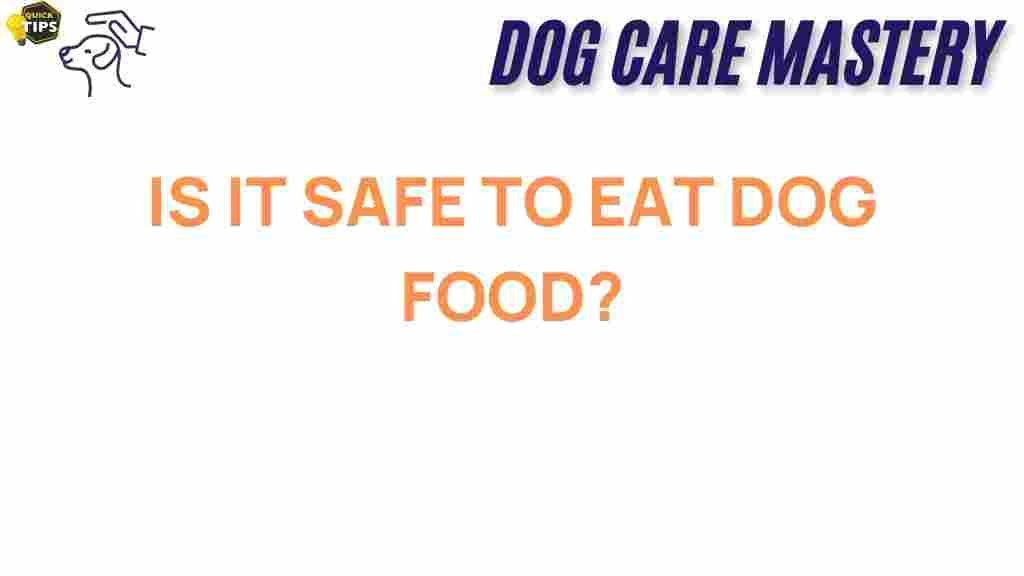Dog Food Safety: Is It Safe to Eat Dog Food?
When it comes to the topic of dog food safety, many people are surprised to learn that some dog foods contain ingredients that are also found in human food. This raises an intriguing question: Is it safe for humans to eat dog food? In this article, we will explore the surprising truth about dog food safety, discussing its ingredients, nutritional value, potential health risks, and when it might be appropriate to consume it.
The Ingredients in Dog Food
Before diving into whether it’s safe for humans to eat dog food, let’s take a closer look at what goes into it. Dog foods generally consist of a combination of:
- Meat and Meat By-products: These can include chicken, beef, lamb, and fish, which are often high in protein.
- Grains: Common grains include corn, wheat, and rice, providing carbohydrates and fiber.
- Vegetables: Ingredients like peas, carrots, and potatoes are included for additional vitamins and minerals.
- Vitamins and Minerals: Essential supplements ensure dogs receive a balanced diet.
While many of these ingredients are indeed safe for human consumption, the quality and preparation of dog food can vary significantly between brands.
Nutritional Value of Dog Food
Dog food is formulated to meet the nutritional requirements of dogs, which differs from human dietary needs. Here are some key points regarding the nutritional value of dog food:
- Protein Levels: Dog food typically has higher protein levels than most human diets, which may be beneficial but could be excessive for humans.
- Fat Content: The fat content in dog food is often higher, which can lead to health issues if consumed regularly by humans.
- Vitamins and Minerals: While dog food is fortified with vitamins and minerals, these may not align with human nutritional guidelines.
In summary, while some ingredients in dog food are safe for humans, it is not designed for human consumption, which raises questions about its long-term effects on human health.
Potential Health Risks
Eating dog food occasionally may not pose a significant health risk, but there are several potential issues to consider:
- Contaminants: Dog food may contain harmful bacteria like Salmonella or E. coli, especially if it is raw or improperly stored.
- Unbalanced Diet: Regular consumption can lead to nutritional imbalances since dog food lacks essential nutrients that humans require.
- Allergic Reactions: Some ingredients might trigger allergies or sensitivities in humans.
To understand these risks better, it’s important to consider the manufacturing process and the regulations that govern pet food safety. The FDA oversees the production of pet food, but regulations are often less stringent than those for human food.
When Is It Appropriate to Consume Dog Food?
There are specific situations where eating dog food might occur. Here are a few examples:
- Emergency Situations: If food is scarce and there are no other options, consuming dog food may be necessary for survival.
- Curiosity: Some people may taste dog food out of curiosity, but this should not become a regular habit.
- Training and Bonding: Dog trainers may taste dog treats to demonstrate to clients the quality of the product.
Even in these scenarios, moderation is key, and one should exercise caution regarding the potential health risks associated with consuming dog food.
Step-by-Step Guide: What to Consider Before Eating Dog Food
If you find yourself considering eating dog food, follow these guidelines:
- Check the Ingredients: Read the label carefully to understand what you are consuming.
- Look for Quality Brands: Choose premium brands that use high-quality ingredients.
- Assess Your Health: Ensure you have no allergies or dietary restrictions that could be triggered by the ingredients.
- Consider Alternatives: If you’re in need of food, opt for human-grade or emergency rations instead.
- Consult a Professional: Speak with a healthcare provider if you’re uncertain about the safety of consuming dog food.
Troubleshooting: What to Do If You Experience Side Effects
If you’ve eaten dog food and begin to notice adverse effects, here’s what to do:
- Stay Hydrated: Drink plenty of water to help flush out any contaminants.
- Monitor Symptoms: Keep track of any symptoms such as nausea, diarrhea, or allergic reactions.
- Seek Medical Attention: If symptoms worsen or you experience severe reactions, contact a healthcare professional immediately.
Being cautious and aware of your body’s responses is crucial when it comes to dog food safety.
Conclusion
In conclusion, while it is technically safe for humans to eat dog food on rare occasions, it is not advisable for regular consumption due to potential health risks and nutritional imbalances. The ingredients in dog food may be safe, but the overall safety standards and formulations are not designed for human dietary needs. If you’re curious about exploring the world of pet food further, or if you want to ensure your dog is eating the best food possible, consider visiting reputable sources such as the FDA’s pet food guidelines.
Ultimately, prioritizing dog food safety is essential for both pets and humans alike. Ensure that what you consume is safe and appropriate for your dietary needs, and remember that there are plenty of human foods that provide the necessary nutrition without the associated risks of eating pet food.
This article is in the category Health and created by dogcaremastery Team
